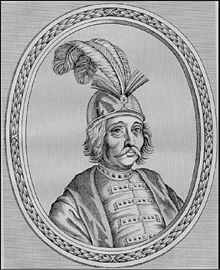Gheorghe Ștefan
This article includes a list of generalreferences,butit lacks sufficient correspondinginline citations.(June 2015) |
| Gheorghe Ștefan | |
|---|---|
 | |
| Prince of Moldavia (1st reign) | |
| Reign | 13 April – 8 May 1653 |
| Predecessor | Vasile Lupu |
| Successor | Vasile Lupu |
| Prince of Moldavia (2nd reign) | |
| Reign | 16 July 1653 – 13 March 1658 |
| Predecessor | Vasile Lupu |
| Successor | George Ghica |
| Born | unknown |
| Died | 1668 Szczecin |
| Father | Dumitrașcu Ceaur |
| Religion | Orthodox |
Gheorghe Ștefan(István Görgicze, seldom referred to asBurduja;died 1668) wasVoivode(Prince) ofMoldaviabetween 13 April and 8 May 1653, and again from 16 July 1653 to 13 March 1658; he was the son ofboyarDumitrașcu Ceaur;Gheorghe Ștefan wasChancellor(logofăt) during the reign ofVasile Lupu.His original name was István Görgicze and is mentioned by this name in many sources. However, due to the difficulty of pronouncing his surname and for certain sources to simplify it, they renamed him Georghe Stephan, referring to the origin of his ancestors from medieval Georgia (Imereti area) orColchis(Kolkhis, land of the legendary Golden Fleece). Nevertheless, all name variations he is mentioned by (Gorgidze, Georgidze, Gergidze, Gergicze, Girgice, Georgicze) mean son of George, representing a historical connection to old Caucasian roots. See sources below.
Biography
[edit]Citing Vasile's reliance on hisGreekandLevantineretinue, as well as an alleged dishonoring of his wife by the Prince, he allied himself withWallachianPrinceMatei BasarabandTransylvanianrulerGeorge II Rákóczi.He managed to expel Vasile Lupu, but the latter was helped to regain his position byBohdan Khmelnytsky's force (under the command of theHetman's sonTymofiy/Tymish), sent to Moldavia to depose him. Tymish and Lupu followed him to Wallachia, but their armies were crushed by Matei Basarab in theBattle of Finta.Gheorghe Ştefan regainedIașiand remained on the throne, making sure that theOttomanpower was appeased - he bought his power inConstantinople,having to increase taxes in order to cover the expenses, and pay for the maintenance of his large mercenary force.
The Turks grew weary of Gheorghe Ștefan's natural alliance with Transylvania and Wallachia (cemented in 1655 by the help he offered toConstantin Șerbanin crushing the rebellion of theseimeniinBucharest), in which they saw the seeds of emancipation. TheSultanMehmed Dördüncüwas irritated further by the active part Moldavia played inPolishmatters duringThe Deluge,in the same camp asSweden,theCossack Hetmanate,Brandenburgand Wallachia. Mehmed understood this to be a step towards the challenge of his own rule: in 1658, he deposed all three subject rulers (Rákóczi, Gheorghe Ștefan, Constantin Șerban), bringingGheorghe I Ghicaas replacement in Iași. All three decided to resist, but Gheorghe Ștefan was defeated atStrunga(Iași County), being discarded from the alliance in favor ofMihnea IIIof Wallachia.
After the unsuccessful war, he found friends and supporters in the Kingdom of Hungary, where he became a Hungarian noble by law according to the Act CXXXIII of 1659 (4. §).[1]
The Prince wandered through Poland andHabsburglands (1662), Brandenburg,Muscovyand Sweden (1665), seeking to find backing for his return. Severely ill and bankrupt, he ended his life inPomerania.His remains were brought back by his wife, and are thought to be buried atCașinMonastery.
References
[edit]- ^"1659. évi CXXXIII. törvénycikk | 1000 év törvényei".1000ev.hu.Retrieved14 June2015.
Bibliography
[edit]- Österreichische Geschichts-Quellen: Scriptores. Erste Abtheilung,p. 199, atGoogle Books
- Fontes Rerum Austriacarum,p. 199, atGoogle Books
- Gróf Mikó Imre, Szabó Károly: Erdély Történelmi Adatok,p. 156, atGoogle Books
- Kispál László: Erdély fejedelmi korszakaatGoogle Books
- Báró Jósika Miklós: II. Rákóczy FerenczatGoogle Books
